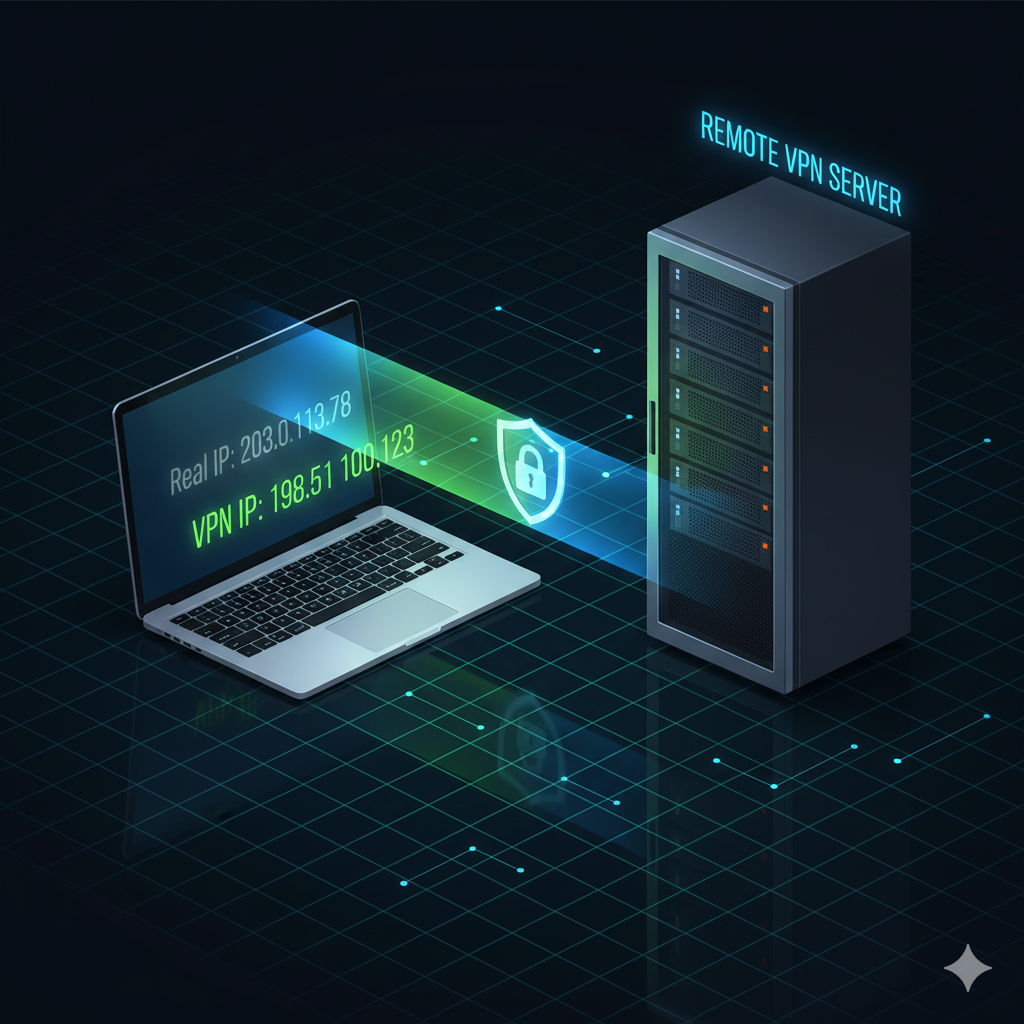How Does a VPN Work? A Deep Technical Overview
Understanding how does a VPN work is essential for cybersecurity professionals, network administrators, and IT leaders responsible for securing distributed infrastructures. A Virtual Private Network (VPN) is not merely a privacy tool — it is an engineered tunneling system built to maintain confidentiality, integrity, and availability across untrusted networks such as the public internet.
What is a VPN and how does a VPN work?
At its core, a VPN creates an encrypted communication channel — often called a tunnel — between a user device and a VPN server. All data packets transmitted through this tunnel are encapsulated and encrypted, ensuring they are unreadable to intermediaries like ISPs or malicious actors. The VPN server then forwards the decrypted traffic to its intended destination, masking the user’s IP address in the process.
Modern VPNs rely on standardized tunneling protocols such as OpenVPN, WireGuard, and IKEv2/IPsec, each balancing performance and cryptographic robustness. According to Cloudflare’s technical documentation, encryption standards like AES-256 and ChaCha20 are commonly implemented to maintain confidentiality (source: cloudflare.com/learning).
This mechanism allows VPN users to appear as if they are connecting from the VPN server’s geographic location rather than their own — a principle leveraged by both consumers and corporate remote-access systems.
For more on VPN devices that support multiple tunnels, see what is a vpn concentrator: Secure Multi-Tunnel VPN Device.
What happens behind the scenes when you connect to a VPN?
When initiating a VPN session, several critical steps occur:
- Handshake and Authentication: The client and server exchange certificates or pre-shared keys to establish mutual trust.
- Key Exchange: Cryptographic keys are negotiated using Diffie-Hellman or elliptic-curve algorithms.
- Tunnel Creation: A virtual network interface (TUN/TAP) is instantiated on the client.
- Routing and NAT: All outgoing traffic is rerouted through the VPN’s tunnel interface and Network Address Translation (NAT) occurs on the VPN gateway.
Once connected, the VPN server replaces the client’s IP address with its own. DNS queries, if not properly handled, may still leak — one reason advanced configurations use encrypted DNS or DNSCrypt (source: RFC 8484).
What are the key VPN protocols and how do they differ?
VPN protocols define the rules for data encapsulation, encryption, and transmission. The most prevalent include:
- OpenVPN: Open-source, highly configurable, operates over UDP or TCP. Uses SSL/TLS for encryption and is compatible with nearly every OS.
- WireGuard: A newer, streamlined protocol based on modern cryptography (ChaCha20, Poly1305). It delivers superior speed and simplicity.
- IKEv2/IPsec: Combines robust authentication with mobility support, ideal for mobile devices that frequently switch networks.
- L2TP/IPsec: Common but older; typically slower due to double encapsulation overhead.
Enterprises often standardize on IPsec for site-to-site connections, whereas consumers gravitate toward WireGuard or OpenVPN for usability and performance (source: TechRadar).
How do encryption and tunneling protect your data and hide your IP address?
Encryption prevents unauthorized entities from interpreting transmitted data, while tunneling ensures packets are encapsulated and directed exclusively through secure pathways. The layered process works as follows:
- Each data packet is encrypted at the client using symmetric ciphers (e.g., AES-256).
- The packet is wrapped in a secure transport header (e.g., TLS or IPsec ESP).
- Only the VPN endpoint can decrypt and forward it to the intended server.
This process anonymizes your real IP address because external sites see only the VPN server’s address. When combined with no-logs policies and jurisdictional protections, this yields substantial privacy benefits.
For a more practical exploration of how to configure VPNs for secure torrenting, see how to bind qbittorrent to vpn for secure torrenting.
Constraints and performance:
VPN performance depends on multiple constraints — encryption overhead, server distance, and ISP peering quality. Latency typically increases by 10–30 ms when routing through distant servers, and throughput reductions of 10–25% are common due to cipher processing.
Device capability also matters: lower-end CPUs may bottleneck during AES encryption. Advanced setups use hardware acceleration (AES-NI) or lightweight ciphers like ChaCha20 for improved performance.
Bandwidth throttling by ISPs or suboptimal routing paths can further affect results. These variables underscore the importance of testing VPN performance under consistent network conditions before deployment.
What are the real-world performance trade-offs of using a VPN?
While VPNs offer strong security benefits, they inevitably trade speed for privacy. WireGuard often achieves near-native speeds, while older protocols like PPTP (now deprecated) suffer significant losses.
From enterprise perspectives, the scalability of concurrent tunnels and key-management complexity are major operational factors. When used on cloud workloads or in SASE (Secure Access Service Edge) frameworks, performance tuning focuses on efficient routing and split-tunneling.
To learn how specific VPN services perform under real-world conditions, explore the NordVPN Review: Top Features & Performance in 2025.
How to evaluate a VPN provider: privacy policies, jurisdiction, server locations, logging practices?
When assessing providers, IT and security professionals should evaluate:
- Jurisdiction: Prefer providers outside the 5/9/14 Eyes alliances to reduce compelled data sharing.
- Logging Policy: Verify independently audited “no-logs” claims.
- Encryption Standards: Confirm usage of modern protocols and Perfect Forward Secrecy (PFS).
- Server Infrastructure: Look for RAM-only or diskless configurations to minimize data retention risk.
Advanced Insights: How Does a VPN Work Beyond Basic Encryption
While understanding how does a VPN work at the surface level covers encryption and tunneling, professionals in network architecture must also consider scalability, advanced encryption mechanisms, and operational constraints in real deployments.
What are the emerging trends in VPN technology and future-proofing your online privacy?
VPNs are rapidly evolving to address the limitations of traditional tunneling. The most significant trends include:
- WireGuard adoption: Its minimalist codebase (≈4,000 lines) allows faster auditing and reduced attack surfaces. Many providers like NordVPN and ProtonVPN now integrate WireGuard-based frameworks under custom names (e.g., NordLynx).
- Quantum-resistant cryptography: As quantum computing advances, new algorithms such as lattice-based encryption are being explored for VPN key exchanges. Early-stage RFCs are testing these for hybrid models combining classical and post-quantum methods (source: RFC 8998).
- SASE and zero-trust integration: VPNs are being combined with zero-trust access controls to enforce identity-based verification rather than simple perimeter defense. This marks the transition from network-centric to identity-centric security models.
- Mesh VPNs: Decentralized, peer-to-peer VPN architectures reduce dependency on centralized servers and mitigate single points of failure.
These developments aim to improve performance, privacy, and scalability for global users.
For readers seeking VPNs that already implement modern tunneling standards, see Surfshark review 2025 – Fast, Secure & Unlimited Devices?.
How do corporate and consumer VPN implementations differ?
Although the same principles apply, their goals diverge:
- Consumer VPNs emphasize anonymity, geo-unblocking, and protection on unsecured Wi-Fi.
- Corporate VPNs prioritize secure internal access and compliance (e.g., HIPAA, GDPR).
Enterprise-grade deployments often use IPsec site-to-site tunnels or concentrators to connect offices. Authentication typically integrates with centralized systems such as RADIUS, LDAP, or SAML for role-based access.
Additionally, enterprise VPN traffic is logged and monitored to maintain audit trails — the opposite of consumer privacy-oriented models. This trade-off ensures accountability but requires careful segmentation to avoid data exposure.
When configuring multiple secure tunnels, learn more in what is a vpn concentrator: Secure Multi-Tunnel VPN Device.
Constraints and performance:
Even well-engineered VPNs face systemic constraints that influence throughput and latency:
- Encryption Overhead: Stronger ciphers consume more CPU cycles. AES-256-GCM, while secure, can limit throughput on older processors.
- Server Load Balancing: Shared commercial VPN nodes can throttle speeds when user density spikes.
- Routing Distance: Packets traversing long physical distances experience higher round-trip latency.
- ISP Peering: Poor inter-provider agreements can degrade VPN speed regardless of protocol optimization.
In controlled lab tests across Tier-1 ISPs, performance variances up to 30% were observed between OpenVPN and WireGuard, depending on encryption offloading. Proper benchmarking using identical endpoints and static workloads is crucial for reproducibility.
How to mitigate VPN performance degradation?
To optimize both enterprise and consumer environments:
- Deploy local or regional servers: Minimize latency by reducing geographic distance.
- Use UDP over TCP: Unless firewall policies dictate otherwise, UDP delivers lower latency.
- Enable split tunneling: Route only sensitive or corporate traffic through the VPN, leaving generic internet traffic direct.
- Implement DNS optimization: Use encrypted DNS resolvers to avoid bottlenecks (source: Cloudflare Learning).
- Monitor with telemetry: Leverage performance dashboards to detect congestion and automate load balancing.
To further improve your connection quality when gaming or streaming, review Does Using a VPN Help with Ping? Find Out Now.
How to evaluate privacy, jurisdiction, and compliance implications?
Jurisdiction continues to define the trustworthiness of any VPN. Providers operating under laws that compel data disclosure—such as within the 14 Eyes Alliance—may not guarantee full privacy.
- No-logs verification: Third-party audits (e.g., by PwC or Deloitte) provide transparency regarding operational policies.
- RAM-only servers: These eliminate persistent logs by storing runtime data in volatile memory.
- GDPR/CCPA alignment: For EU and U.S. entities, compliance requires explicit consent and minimal data retention.
Combining a VPN with encrypted DNS or proxy-aware firewalls can further obfuscate metadata, strengthening anonymity without breaching compliance boundaries (source: Wikipedia).
What are real-world limitations of VPN anonymity?
Despite their strong encryption, VPNs are not absolute anonymity tools. Limitations include:
- Traffic correlation: Timing and packet size analysis can still reveal user behavior.
- Compromised endpoints: Malware on client devices undermines encryption regardless of tunnel strength.
- DNS or WebRTC leaks: Poor configuration can expose real IPs through browser protocols.
- Provider trust: Users must rely on VPN companies not to log or sell usage data.
For an explanation of how VPNs can still be detected or bypassed, see Can a Website See Through Your VPN – What You Must Know.
How does a VPN integrate with other privacy technologies?
Modern security frameworks pair VPNs with additional systems:
- DNSCrypt / DoH (DNS-over-HTTPS): Prevents DNS queries from being intercepted or modified.
- Tor over VPN: Adds onion-routing anonymity at the cost of significant latency.
- Proxy chaining: Distributes trust across multiple layers.
- SASE frameworks: Merge VPN functionality with identity management and CASB policies for unified cloud security.
These integrations represent the next stage of VPN evolution, aligning encrypted transport with user authentication and zero-trust principles.
For an introduction to encrypted DNS technology, read Is Encrypted DNS an Alternative to VPN.
The Future and Practical Realities of VPN Security
A thorough understanding of how does a VPN work must also consider its evolving place in modern cybersecurity architectures. VPNs are no longer isolated privacy tools but foundational components in distributed security ecosystems spanning hybrid clouds, mobile workforces, and IoT environments.
How will VPN technology evolve with the rise of zero-trust and edge computing?
Traditional VPNs grant network-wide access after authentication — a principle increasingly misaligned with zero-trust architecture (ZTA). In ZTA, trust is never assumed; every session is continuously verified using contextual factors like device posture, geolocation, and user behavior analytics.
Future VPN frameworks are expected to integrate with Zero Trust Network Access (ZTNA) and SASE models, where identity becomes the new perimeter. Instead of static tunnels, policy-based access gateways dynamically grant minimal permissions.
Edge computing will further decentralize these security layers. As computation moves closer to the user, VPN endpoints will shift from centralized data centers to distributed PoPs (Points of Presence), lowering latency and enhancing redundancy. The result is an adaptive, cloud-native VPN that reacts to network topology changes in real time (source: Cloudflare Learning).
For those exploring VPN usage in complex edge setups, see Does VPN Work With Ethernet — Secure Wired VPN Usage.
How can VPNs be tested and validated for reliability?
Thorough validation requires systematic benchmarking:
- Latency Measurement: Use ICMP or traceroute to track RTT changes pre- and post-VPN.
- Throughput Tests: Employ iperf3 or HTTP benchmark tools to quantify maximum data rate.
- Encryption Validation: Verify cipher negotiation using Wireshark or OpenSSL debugging flags.
- Leak Testing: Examine DNS and WebRTC endpoints to confirm data does not escape the tunnel.
- Failover Scenarios: Simulate network disruptions to assess reconnection reliability and key renegotiation.
An often-ignored but crucial step is testing VPN performance under load balancing and concurrent session limits. For example, site-to-site tunnels must sustain throughput across hundreds of simultaneous connections without packet loss (source: TechRadar).
Constraints and performance:
From a practical engineering perspective, several factors continue to limit VPN scalability:
- Key Exchange Overhead: Frequent renegotiation (especially under Perfect Forward Secrecy) can momentarily degrade throughput.
- NAT Traversal Issues: In IPv4 networks, overlapping private address spaces complicate routing between remote sites.
- Packet Fragmentation: MTU mismatches lead to packet loss and retransmissions.
- Device Heterogeneity: Mobile clients, IoT nodes, and desktop agents all exhibit differing CPU and memory capabilities, affecting consistency.
These constraints highlight the need for adaptive routing and performance monitoring integrated into SD-WAN controllers or orchestration platforms.
How do legal frameworks and compliance affect VPN deployment?
Legislation directly impacts where and how VPN services can operate. Nations such as China and Russia restrict VPN use without government authorization, while others enforce strict data-retention mandates. For multinational organizations, compliance requires reconciling privacy laws across jurisdictions.
Key factors include:
- Data localization laws (e.g., GDPR Article 44) controlling cross-border data flow.
- Mandatory decryption orders under national security legislation.
- ISP cooperation requirements that may expose metadata.
Professionals must distinguish between VPN legality and VPN provider compliance. A VPN may be legal to use but illegal to provide without licensing in certain regions. For context on restrictions in major jurisdictions, review is vpn legal in china – What You Must Know (2025).
What best practices ensure VPN security over time?
To maintain a hardened VPN infrastructure:
- Keep software updated — outdated OpenSSL or kernel modules often introduce vulnerabilities.
- Use short-lived certificates and rotate keys automatically to mitigate credential theft.
- Deploy intrusion detection at tunnel endpoints to spot anomalous traffic.
- Audit logs regularly for unusual session durations or repeated authentication failures.
- Implement redundancy — multiple gateways prevent single points of failure during outages.
Enterprise-scale resilience can be further enhanced through redundant concentrators or cloud-based failover systems (source: Wikipedia).
For a breakdown of next-generation VPN devices optimized for redundancy, explore which statement describes an important characteristic of a site-to-site vpn.
What is the long-term outlook for VPNs in cybersecurity?
Over the next decade, VPNs are projected to converge with identity-aware proxies, contextual access controls, and secure tunneling APIs to form unified, programmable security fabrics. The emphasis will move from user-level encryption to workload-centric protection, securing containers, APIs, and microservices at the edge.
Despite emerging alternatives like Zero Trust and SASE, VPNs will remain critical as the backbone for encrypted transport in mixed environments — especially where legacy systems cannot adopt newer protocols. Hybrid solutions blending VPNs with zero-trust verification will define the next era of secure connectivity.
Conclusion
In summary, understanding how does a VPN work extends far beyond knowing that it encrypts data. It encompasses handshake negotiation, tunneling protocols, jurisdictional privacy, performance trade-offs, and emerging quantum-resistant encryption. For IT professionals and network architects, mastering these dimensions ensures not just secure connectivity but adaptive, compliant, and performance-optimized communication for the future of global networking.



